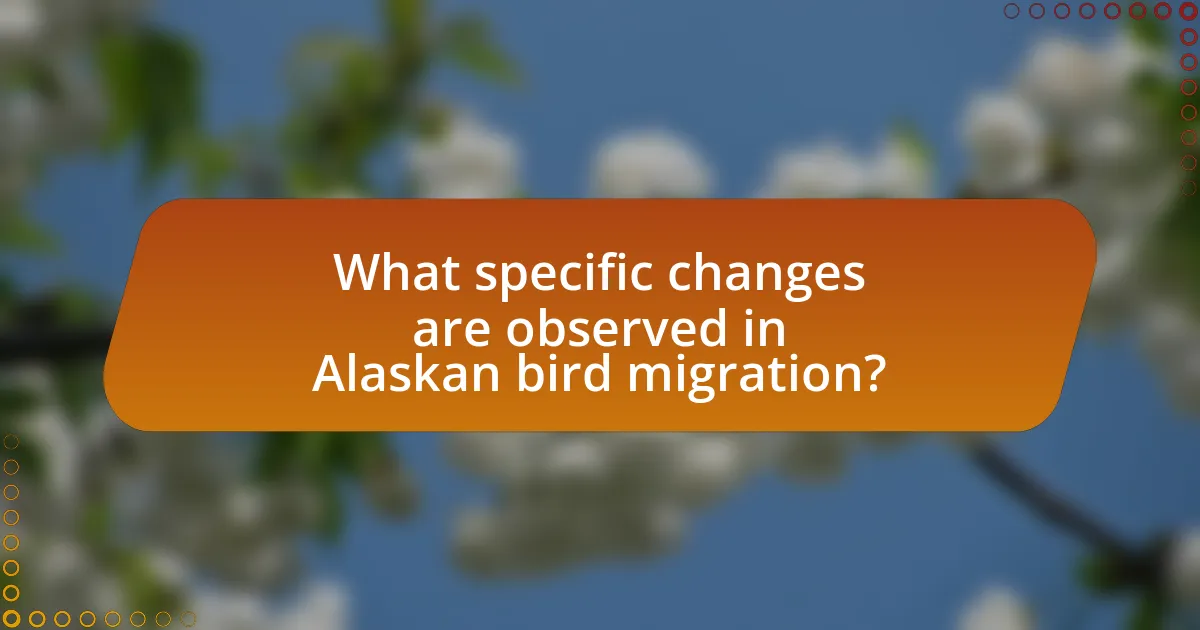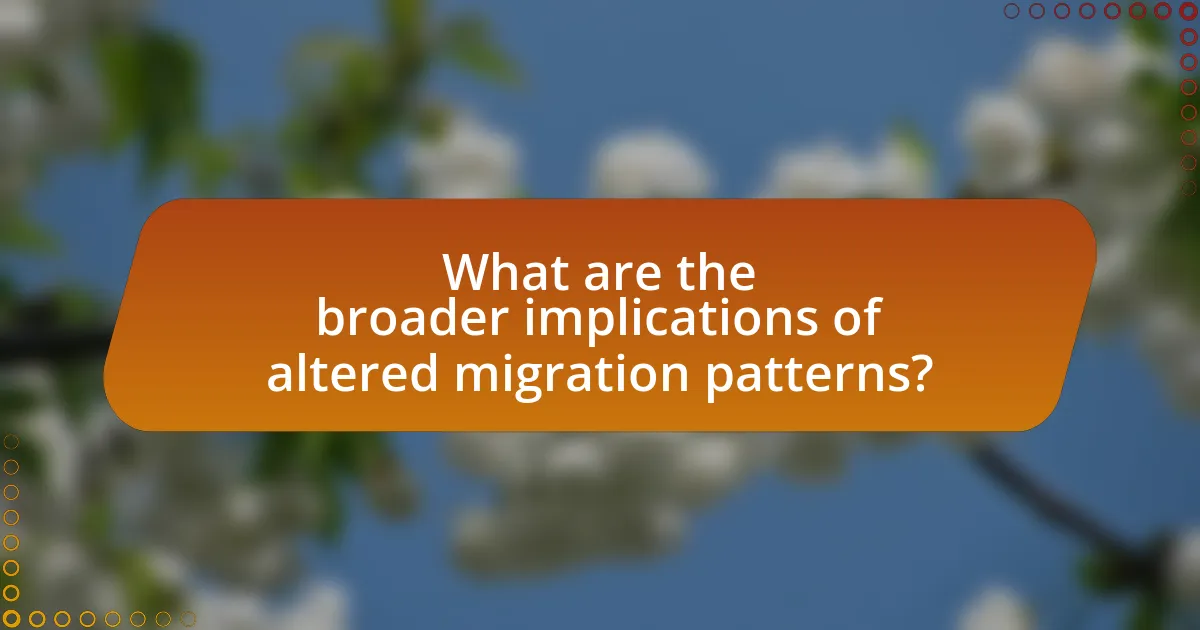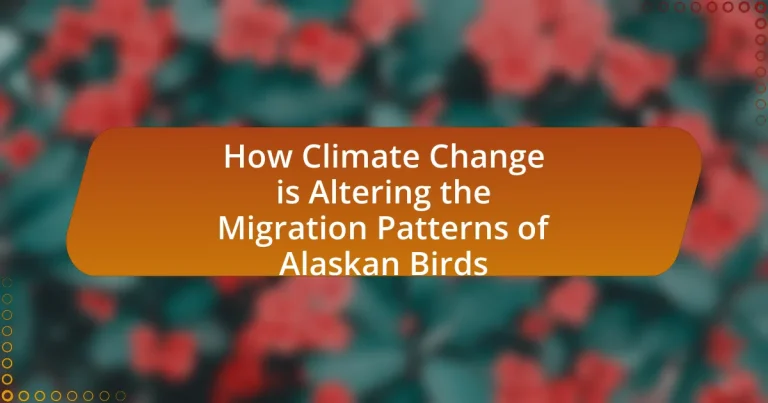Climate change is significantly impacting the migration patterns of Alaskan birds, leading to earlier migration timings, altered routes, and changes in species composition. Warmer temperatures are causing birds like the Arctic Tern to arrive at breeding grounds up to two weeks earlier, disrupting their synchronization with food availability. Key factors influencing these changes include rising temperatures, altered precipitation patterns, and habitat loss, which collectively threaten bird survival and ecosystem balance. Understanding these shifts is crucial for biodiversity, as they can lead to mismatches in breeding and food sources, ultimately affecting the health of entire ecosystems. Conservation strategies, including habitat protection and policy changes, are essential to mitigate these impacts and support affected bird species.
How is Climate Change Impacting Alaskan Birds’ Migration Patterns?
Climate change is significantly altering Alaskan birds’ migration patterns by causing shifts in their timing and routes. Warmer temperatures lead to earlier springs, prompting species like the Arctic Tern to migrate sooner than in previous decades. Research indicates that some birds are arriving at breeding grounds up to two weeks earlier, which disrupts their synchronization with food availability, such as insects and plants that also respond to temperature changes. Additionally, changing weather patterns and habitat loss due to climate change are forcing some species to adapt their migration routes, potentially leading to increased competition for resources and challenges in breeding success.
What are the primary factors of climate change affecting bird migration?
The primary factors of climate change affecting bird migration include rising temperatures, altered precipitation patterns, and changes in food availability. Rising temperatures can lead to earlier springs, causing birds to migrate sooner than usual, which disrupts their synchronization with food sources. Altered precipitation patterns can affect the habitats and breeding grounds of birds, making them less suitable for nesting. Additionally, changes in food availability, driven by climate change, can impact the timing and success of migration, as birds rely on specific food sources during their journeys. Studies have shown that these factors collectively influence the migratory behavior and survival rates of various bird species.
How do temperature changes influence migration timing?
Temperature changes significantly influence migration timing by altering the availability of food resources and breeding conditions for birds. As temperatures rise, the timing of seasonal events, such as the blooming of plants and the emergence of insects, shifts earlier in the year. This earlier availability of food can lead birds to migrate sooner to take advantage of these resources. For instance, studies have shown that many Alaskan bird species are migrating earlier in response to warmer temperatures, with some species advancing their migration by several weeks over the past few decades. This shift can disrupt the synchronization between birds and their food supply, potentially affecting their reproductive success and survival rates.
What role does habitat alteration play in migration routes?
Habitat alteration significantly disrupts migration routes by changing the availability of food, nesting sites, and resting areas for birds. For instance, the transformation of wetlands into agricultural land reduces the habitat necessary for migratory birds to stop and refuel during their journeys. Research indicates that such alterations can lead to shifts in migration timing and routes, as birds may be forced to adapt to new environments or face increased mortality rates. A study published in the journal “Ecology Letters” highlights that habitat loss due to climate change has been linked to a decline in migratory bird populations, emphasizing the critical role of intact habitats in supporting migration.
Why is understanding these changes important for biodiversity?
Understanding changes in migration patterns due to climate change is crucial for biodiversity because it directly impacts species survival and ecosystem health. Altered migration can lead to mismatches in breeding and food availability, threatening bird populations and the species that depend on them. For instance, studies have shown that shifts in timing can disrupt the synchronization between migratory birds and their food sources, such as insects, which can decline in abundance if they emerge too early or too late. This disruption can lead to decreased reproductive success and increased mortality rates among birds, ultimately affecting the entire ecosystem.
How do altered migration patterns affect ecosystem balance?
Altered migration patterns disrupt ecosystem balance by affecting species interactions and food web dynamics. When birds migrate earlier or later than usual due to climate change, it can lead to mismatches between the timing of their arrival and the availability of food resources, such as insects and plants. For instance, if migratory birds arrive before their food sources are abundant, their survival and reproductive success may decline, which can reduce their populations. This decline can have cascading effects on the ecosystem, as these birds often play critical roles in pollination, seed dispersal, and pest control. Research indicates that changes in migration timing can lead to shifts in community composition and biodiversity, ultimately destabilizing the ecosystem.
What are the implications for bird species survival?
Climate change significantly threatens bird species survival by disrupting their migration patterns and altering habitats. As temperatures rise and weather patterns shift, many Alaskan bird species are experiencing changes in food availability and nesting sites, which can lead to decreased reproductive success. For instance, studies have shown that species like the Arctic Tern are arriving at breeding grounds earlier than usual, resulting in mismatches between the timing of chick hatching and peak food availability. This mismatch can lead to higher mortality rates among young birds, ultimately impacting population stability. Additionally, habitat loss due to climate-induced changes, such as melting ice and altered vegetation, further exacerbates the challenges faced by these species, making it increasingly difficult for them to survive in their traditional environments.

What specific changes are observed in Alaskan bird migration?
Specific changes observed in Alaskan bird migration include earlier arrival dates, altered migration routes, and shifts in species composition. Research indicates that many bird species are arriving in Alaska up to two weeks earlier than they did several decades ago, which correlates with rising temperatures and changing food availability. Additionally, some species are migrating further north than previously recorded, adapting to the changing climate and habitat conditions. For instance, studies have shown that the population of certain migratory birds, such as the Arctic Tern, is increasingly utilizing new feeding grounds as ice melts earlier in the season. These changes highlight the direct impact of climate change on the migratory behaviors of Alaskan birds.
How have migration timings shifted in recent years?
Migration timings of Alaskan birds have shifted earlier in recent years due to climate change. Studies indicate that many species are now arriving at their breeding grounds up to two weeks earlier than they did a few decades ago, correlating with rising temperatures and changing food availability. For instance, research published in the journal “Ecology Letters” by both the University of Alaska and the U.S. Geological Survey highlights that the timing of migration for species like the Arctic Tern has advanced significantly, impacting their reproductive success and ecosystem dynamics.
What evidence supports the changes in migration schedules?
Changes in migration schedules of Alaskan birds are supported by evidence from long-term observational studies that document shifts in arrival and departure dates. For instance, research conducted by the U.S. Geological Survey indicates that many bird species are migrating earlier in the spring and later in the fall due to rising temperatures and altered food availability. Specifically, studies have shown that the arrival of migratory birds like the Arctic Tern has advanced by an average of 10 days over the past few decades, correlating with increased temperatures in their breeding habitats. Additionally, satellite tracking data reveals changes in flight paths and timing, further substantiating the impact of climate change on these migratory patterns.
Which species are most affected by these timing shifts?
The species most affected by timing shifts due to climate change in Alaska include the Western Sandpiper, the Red-necked Phalarope, and the Arctic Tern. These bird species rely on specific migratory patterns that are disrupted by changes in temperature and food availability. For instance, studies have shown that the Western Sandpiper’s migration is increasingly misaligned with the peak abundance of its food sources, such as invertebrates, which are also affected by climate change. This misalignment can lead to decreased reproductive success and survival rates for these birds.
What new migration routes are being established?
New migration routes for Alaskan birds are being established as a direct response to climate change, which is altering their traditional pathways. Research indicates that warming temperatures and shifting ecosystems are prompting species such as the Arctic Tern and the Red-throated Diver to adapt by changing their migratory patterns, often moving further north or altering the timing of their migrations. For instance, studies have shown that the arrival dates of some bird species in their breeding grounds have shifted earlier by several weeks due to increased temperatures, indicating a significant change in their migratory behavior.
How do these new routes compare to historical patterns?
New migration routes for Alaskan birds show significant deviations from historical patterns, primarily due to climate change. Historically, many species migrated along consistent routes aligned with seasonal weather patterns and food availability. However, recent studies indicate that rising temperatures and altered ecosystems have led to earlier migrations and shifts in traditional pathways. For example, species like the Arctic Tern have been observed migrating earlier by up to two weeks compared to historical records, as documented in research published by the Audubon Society. This shift is attributed to changes in breeding and feeding grounds, which are now influenced by warmer temperatures and changing habitats.
What factors are driving the establishment of these new routes?
Climate change is driving the establishment of new migration routes for Alaskan birds. Rising temperatures and shifting weather patterns are altering the availability of food sources and suitable habitats, prompting birds to adapt their migratory paths. For instance, studies have shown that earlier springs and changing precipitation patterns affect the timing of food availability, leading birds to migrate earlier or to different locations to optimize their survival and reproductive success.

What are the broader implications of altered migration patterns?
Altered migration patterns of Alaskan birds due to climate change have significant ecological and socio-economic implications. These changes can disrupt local ecosystems, as migratory birds play crucial roles in pollination, seed dispersal, and pest control. For instance, a study published in the journal “Ecology Letters” found that shifts in migration timing can lead to mismatches between birds and their food sources, potentially resulting in decreased survival rates. Additionally, altered migration can affect local economies that rely on birdwatching and tourism, as changes in bird populations may deter visitors. Furthermore, these patterns can influence predator-prey dynamics, leading to cascading effects throughout the food web.
How does climate change affect food availability for migratory birds?
Climate change significantly reduces food availability for migratory birds by altering the timing and distribution of their food sources. As temperatures rise, the phenology of plants and insects shifts, often leading to mismatches between the timing of bird migrations and the availability of food. For instance, studies have shown that warmer temperatures can cause insects to emerge earlier in the spring, while many migratory birds may not arrive in their breeding grounds in time to take advantage of this food source. This mismatch can lead to decreased reproductive success and survival rates among these birds, as evidenced by research published in the journal “Ecology Letters,” which highlights the impact of climate-induced changes on food webs and migratory patterns.
What changes in prey populations are linked to climate change?
Climate change is linked to significant changes in prey populations, particularly through shifts in distribution, abundance, and seasonal timing. For instance, warmer temperatures can lead to earlier plant blooming and insect hatching, which affects the availability of food for birds. Research indicates that as temperatures rise, certain insect populations, which serve as crucial prey for many bird species, are emerging earlier in the spring, creating a mismatch between the timing of bird migration and the peak availability of their food sources. This phenomenon has been documented in studies such as those conducted by Both et al. (2006), which found that migratory birds in Europe are arriving at breeding grounds before their primary food sources are available, leading to decreased reproductive success.
How does food scarcity impact bird health and reproduction?
Food scarcity negatively impacts bird health and reproduction by leading to malnutrition and decreased reproductive success. When birds face limited food availability, their energy reserves diminish, which can result in weakened immune systems, making them more susceptible to diseases. Additionally, insufficient nutrition affects the development of eggs and the overall health of hatchlings, leading to lower survival rates. Research indicates that species such as the Arctic Tern have shown reduced breeding success in years of food scarcity, highlighting the direct correlation between food availability and reproductive outcomes.
What conservation strategies can mitigate these impacts?
Conservation strategies that can mitigate the impacts of climate change on the migration patterns of Alaskan birds include habitat protection, restoration of critical ecosystems, and the establishment of wildlife corridors. Habitat protection ensures that essential breeding and feeding grounds remain intact, which is crucial as changing climates may shift the availability of these resources. Restoration of ecosystems, such as wetlands and forests, can enhance resilience against climate impacts, providing birds with necessary resources during migration. Additionally, creating wildlife corridors facilitates safe passage for birds between habitats, allowing them to adapt to changing conditions. These strategies are supported by studies indicating that preserving and enhancing habitats can significantly improve the survival rates of migratory species facing climate-related challenges.
How can habitat restoration support affected bird species?
Habitat restoration can significantly support affected bird species by re-establishing essential ecosystems that provide food, shelter, and breeding grounds. For instance, restoring wetlands can enhance the availability of resources for migratory birds, which rely on these habitats during their journeys. Research indicates that habitat restoration efforts, such as replanting native vegetation and removing invasive species, can lead to increased bird populations and diversity. A study published in the journal “Ecological Applications” found that restored habitats can improve the survival rates of migratory birds by up to 30%, demonstrating the direct benefits of such initiatives on avian populations.
What role do policy changes play in protecting migratory birds?
Policy changes play a crucial role in protecting migratory birds by establishing legal frameworks that regulate habitat conservation, hunting practices, and climate change mitigation. For instance, the Migratory Bird Treaty Act in the United States provides legal protection for migratory bird species, making it illegal to harm or kill them without a permit. Additionally, policies aimed at reducing greenhouse gas emissions can help mitigate climate change impacts, which are altering migration patterns and habitats for these birds. Research indicates that effective policy implementation can lead to improved habitat quality and increased bird populations, demonstrating the direct correlation between policy changes and the protection of migratory birds.
What actions can individuals take to support Alaskan birds amidst climate change?
Individuals can support Alaskan birds amidst climate change by participating in habitat restoration projects, reducing carbon footprints, and advocating for conservation policies. Habitat restoration, such as planting native vegetation and removing invasive species, directly benefits bird populations by providing essential resources. Reducing carbon footprints through energy conservation and sustainable practices helps mitigate climate change impacts, which are altering migration patterns. Advocacy for conservation policies, such as protecting critical habitats and supporting wildlife corridors, ensures long-term protection for Alaskan birds facing climate-related challenges.


